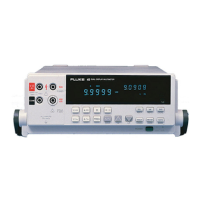Performance Testing and Calibration
Front Panel Calibration
4
4-13
4-13. Alternate Ohms Calibration (Front Panel)
The following procedure can be used with discrete resistor values (such as a decade
box). On the 300 Ω range, this alternate procedure uses a 290 Ω source and yields a
specification of 0.05%+2 digits +0.02 Ω. Alternate calibration of this range is detailed
below, although discrete resistor values can be used for all ranges. Lead and source zero
resistances are only taken into account for the lowest two ranges (300 Ω and 3 kΩ).
1. Connect the ohms source to the meter. Apply zero ohms.
2. Measure and record the residual lead and source zero resistance on the 300Ω range.
3. Add the value from the lead and source zero resistance from step 2 above to the
certified value of the source resistor.
4. Set the meter to the calibration mode (press the Cal Enable button.) Select ohms
calibration.
5. Using the editor buttons, edit the meter display prompt to the value calculated in step
3.
6. Press
E to calibrate this range.
4-14. Continuity/Hysteresis Threshold Calibration (Front Panel)
Perform the calibration as follows:
1. If the meter is already in calibration mode, press the
U or T button to select
Q calibration. Otherwise, select calibration mode first (press Cal Enable button
for three seconds), then select
Q calibration by pressing the U button seven
times.
2. Connect the output of the dc voltage source to the
X and COM input of the
meter.
3. Apply the outputs indicated in Table 4-5, and calibrate using the
E button.
4-15. Frequency Calibration (Front Panel)
If the meter is already in calibration mode, press the
U button to select Hz calibration.
Otherwise, select calibration mode first (press Cal Enable button for three seconds), then
select Hz calibration by pressing the
U button eight times. Complete step 32 of Table
4-5
4-16. C2 Adjustment Procedure
The following procedure can be performed on meters that fail to meet the performance
test limits for high frequency VAC. The procedure is performed separately after all other
VAC calibration steps are completed. It is not necessary to enter the calibration mode to
adjust C2.
1. Remove the top shield (MP11).
2. Set the UUT to VAC
3. Apply 15 mV, 1 kHz to the UUT input.
4. Record the UUT display reading.
5. Apply 15 mV, 20 kHz to the UUT input.
6. Adjust C2 until the UUT display reads 40 µV less that the reading recorded in Step
4.

